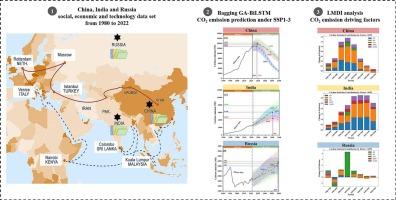解读绿色一带一路代表性国家的二氧化碳期货——来自中国、印度和俄罗斯的证据
IF 11.2
1区 社会学
Q1 ENVIRONMENTAL STUDIES
引用次数: 0
摘要
全球气温上升对“一带一路”倡议国家构成了严峻挑战,这些国家必须在向低碳发展过渡的同时保持经济增长。然而,现有的模型往往过于简化了排放动态及其关键驱动因素。该研究开发了Bagging GA-BiLSTM框架,并针对三种机器学习模型(LSTM、极端梯度增强、随机森林)和传统的STIRPAT-OLS模型评估了其性能,从而实现了2023年至2060年中国、印度和俄罗斯多个情景(SSP1、SSP2、SSP3)和变量的高精度部门排放预测。采用对数平均分割指数(LMDI)方法评估驱动因素和解耦模式的贡献。Bagging GA-BiLSTM比其他模型具有更高的R2和更低的均方误差。在SSP1下,中国的排放量在2027年达到峰值12.81±2 Gt,到2060年下降到2.87±0.4 Gt。在SSP2和SSP3下,碳排放峰值推迟到2029年。印度的排放量预计将在2050年至2051年之间达到峰值,并存在很大的情景差异。俄罗斯表现出收缩-复苏-反弹的轨迹,在SSP1下,排放量在2058年达到峰值2.38±0.3Gt。LMDI分解表明,中国和印度的碳排放变化主要受产业结构和能源强度的驱动,反映了快速发展经济体的特征。俄罗斯则呈现出以经济和城市化因素为主的后工业化排放格局。这些研究结果从数量上强化了现有的政策路径,证明了差异化战略——如低收入国家的基础设施投资、中等收入经济体的效率提高和资源丰富国家的制度改革——对于整个“一带一路”有效的低碳转型仍然至关重要。本研究提供了更新和详细的基于场景的证据,加强和深化了这些既定战略的基础。本文章由计算机程序翻译,如有差异,请以英文原文为准。

Decoding CO₂ futures in representative Green Belt and road countries: Evidence from China, India, and Russia
Rising global temperatures pose a critical challenge for Belt and Road Initiative (BRI) nations, which must sustain economic growth while transitioning to low-carbon development. However, existing models often oversimplify emissions dynamics and their key drivers. The study developed a Bagging GA-BiLSTM framework and evaluated its performance against three machine learning models (LSTM, Extreme Gradient Boosting, Random Forest) and a conventional STIRPAT-OLS model, enabling high-precision projection of sectoral emissions across multiple scenarios (SSP1, SSP2, SSP3) and variables for China, India, and Russia from 2023 to 2060. The Logarithmic Mean Divisia Index (LMDI) method was employed to assess the contribution of driving factors and decoupling patterns. The Bagging GA-BiLSTM achieves higher R2 and lower mean squared errors than other models. Under SSP1, China's emissions peak at 12.81 ± 2 Gt in 2027 and decline to Gt by 2060. Under SSP2 and SSP3, carbon peak emissions are delayed to 2029. India's emissions are projected to peak between 2050 and 2051, with substantial scenario-based variability. Russia exhibits a contraction-recovery-rebound trajectory, with emissions peaking at Gt in 2058 under SSP1. LMDI decomposition reveals that carbon emission changes in China and India are primarily driven by industrial structure and energy intensity, reflecting the characteristics of rapidly developing economies. In contrast, Russia exhibits a post-industrial emission pattern dominated by economic and urbanization factors. These findings quantitatively reinforce existing policy pathways, proving that differentiated strategies-such as infrastructure investment in low-income countries, efficiency improvements in middle-income economies, and institutional reforms in resource-rich nations-remain essential for effective low-carbon transitions across the BRI. This study provides updated and detailed scenario-based evidence that strengthens and deepens the foundation for these established strategies.
求助全文
通过发布文献求助,成功后即可免费获取论文全文。
去求助
来源期刊

Environmental Impact Assessment Review
ENVIRONMENTAL STUDIES-
CiteScore
12.60
自引率
10.10%
发文量
200
审稿时长
33 days
期刊介绍:
Environmental Impact Assessment Review is an interdisciplinary journal that serves a global audience of practitioners, policymakers, and academics involved in assessing the environmental impact of policies, projects, processes, and products. The journal focuses on innovative theory and practice in environmental impact assessment (EIA). Papers are expected to present innovative ideas, be topical, and coherent. The journal emphasizes concepts, methods, techniques, approaches, and systems related to EIA theory and practice.
 求助内容:
求助内容: 应助结果提醒方式:
应助结果提醒方式:


